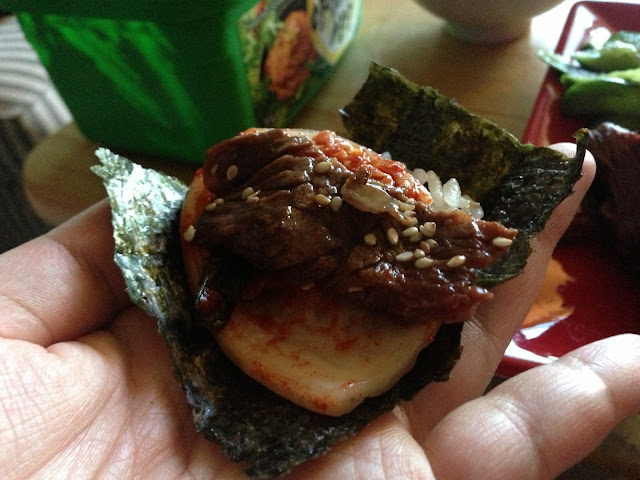Happy LetsLunch, everyone!! I am so excited about this month's theme: dishes to celebrate Asian American/Pacific Islander Heritage Month.
I've written many times about how I often feel trapped between the many cultures I belong to. I've never felt like I could truly identify with being Korean or truly Asian American, since I was not really raised in either culture.
But food has always been a way for me to feel a strong tie with my Korean roots. Would it have been nice to have learned how to make Korean bulgogi from my weihalmonie before she passed away? Of course. But, the beauty of the Internet is that I had Maangchi, right in my own home, acting as my own personal ajumma to teach me my favorite Korean foods, like bulgogi.
So without further ado, here's my quick and dirty guide to making Korean barbecue at home.
Much of Korean barbecue can be made up as you go. Everyone's mom and grandma makes it differently, as far as I can tell. This recipe relies on finely minced Asian pear and brown sugar for the sweetness. You can also use honey, mashed kiwi or even cola. This marinade, for about 1 lb of meat, is 3/4 cup soy sauce, 1/3 cup rice vinegar, 1/4 cup sesame oil, scant 1/4 cup canola oil, 3 TBS brown sugar, half an Asian pear (finely minced), all whisked together.
Korean barbecue has gotten quite popular, especially in cities with big Korean populations like Washington, D.C. (where I live) and New York City. Within a 20-30 minute drive from my house, there are literally dozens of kogijibs, or meat houses, where barbecue is the specialty. (Pro tip: if you're looking for an outstanding Korean restaurant, look for one that operates in the native Korean style of specializing in one dish or type of food.) I got an early start on this week's dish. The onion slices, mashed garlic and ginger, and some salt and pepper went into a bag with the meat a day or two before I was ready to cook. I added the marinade the morning I was going to grill.
Someday, I aspire to own one of those fabulous one-off butane grills and a tilted Korean barbecue grill like the ones they use at restaurants (or like this one). For now, I have a fabulous electric wok that I absolutely love, and it creates a really nice sear on meat like this. (if you're feeling curious about the meat, this happens to be skirt steak, but you can use almost any thinly-sliced, tender cut of beef you like. I've made it with everything from eye round to filet mignon)
While the meat was resting, I also grilled up the marinated onion slices with some lovely enoki mushrooms. Always buy twice as money enoki mushrooms as you think you'll need--they really shrink down when you cook them!
The benefit of making Korean barbecue at home is you can yank the meat off the grill while it's still medium rare. I'm not a huge fan of how long they usually leave the meat on your grill at Korean barbecue restaurants because it allows the meat to cook completely through. Snip the meat into bite sized pieces with scissors.
No Korean meal would be complete without panchan (two of these are storebought, one is homemade), so load your plate up and enjoy! At a restaurant, you might be given a basket of lettuce leaves (and bitter perilla leaves if you're feeling extra traditional), some sliced garlic, soybean paste and rice to make cute little lettuce wraps.
You can also sub little sheets of gim (this is actually nori, but shhh they're so similar) to wrap around your rice, kimchi and meat! I am fairly certain there is a Korean name for eating your food this way, but I've never managed to pick it up (as it's not something you would see on a menu in a restaurant).
So there you have it, the illustrated guide to Korean barbecue in the home. If you want to make kalbi instead of bulgogi, get short ribs instead of steak. You can get the kind that is pulled off the bone, or the kind sliced sideways, with the bone slivers still in tact.
--
LetsLunch is a monthly meeting of food bloggers from around the world. We share themed blog posts via Twitter, Facebook and Pinterest. We would love to have you join us, just tweet using the hashtag #LetsLunch to introduce yourself!
Check back to see what the others are posting on Friday for Asian American/Pacific Islander Heritage Month:
* Lucy's Chinese Chicken Salad on A Cook and Her Books
* Lisa's Sesame, Eggplant and Noodle Salad on Monday Morning Cooking Club
*
*
*
*






